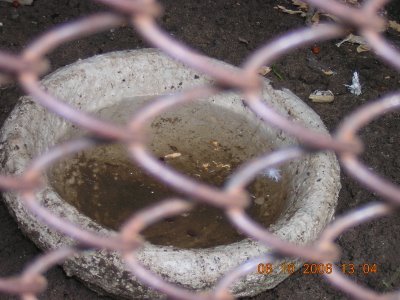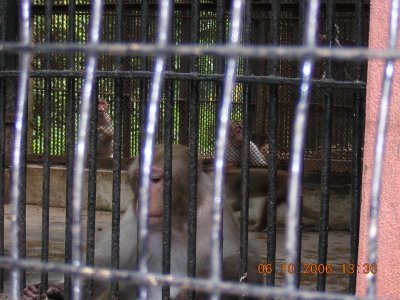Life or Something Like it : Innocence Trapped and Tormented at Alipore Zoo : Environment, General Cleanliness and Zoo visitors
..... Feeding zoo animals with substances foreign to their systems can be damaging to them. Each animal needs a different type of food. They should feed only on what they would in the wild. If they are fed with biscuits, wafers, etc. by the visitors, animals lose their appetite for the type of food they are meant to eat. Animals may also get infected with human diseases when visitors give them food. This can make animals sick and even lead to deaths.
Outside the zoo, despite a sign board instructing visitors not to feed the zoo inmates, there were hawkers selling junk food. They were encouraging the visitors entering the zoo to purchase what they called “food for the monkeys and birds”. In the presence of all the guards near the gates, this business was being run smoothly.
 Photo Desc # A visitor feeds a deer.
Photo Desc # A visitor feeds a deer.
Is there anyone at all responsibe for this animal's well-being to stop this nonsense? For which duty of the guards does the government hire and disburse them? #Photo Desc # The enclosure of the white fallow deer has no stand off barrier.
Zoo Rules 1992 states,” Stand of barriers and adequate warning signs shall be provided for keeping the visitors at a safe distance from the animals.”
This and a lot of other animals are totally reachable to the visitors for feeding and teasing. #

Photo Desc # Visitors beating the net of the enclosure of this bird.
Zoo Rules 1992 states,” Every care shall be taken to avoid discomfort, behavioral stress or physical harm to any animal.”
Wildlife Protection Act 1972 states, “No person shall tease, injure or feed any animal or cause disturbance to the animals by noise or otherwise, or litter the grounds in a zoo.” #
The offence to disturb or tease zoo animals according to the Recognition of Zoo Rules under the Wildlife Protection Act 1972 going unobserved was the last one the list of breaking rules. The Central Zoo Authority guidelines clearly mention that plastic is prohibited from entering zoo premises. Plastic bags, empty as well as with leftover snacks, were dumped on the lawns and even inside animal enclosures which could be swallowed by the animals.
Photo Desc # Plastic packets are lying inside the enclosure of an animal.
If swallowed, it could entangle the intestines (or even something worse) of the animal. #
The restaurants, ice-cream corners and even local vendors openly sold plastic-bagged food items despite having warning boards calling for a prohibition on the same.

Photo Desc # Plastic bags lying on the ground. Plastic bottles and glasses are seen displayed outside the restaurant.
The Central Zoo Authority guidelines clearly mention that plastic is prohibited from entering zoo premises. Plastic bags, empty, as well as with leftover snacks, which are dumped on the lawns or inside animal enclosures, may be swallowed by the animals. Polythene bags are non-biodegradable and cannot be digested. They can clog the digestive tract, and suffocate the animals to death.
This restaurant selling water in plastic bottles and glasses is located at the beginning of the zoo. Contradicting is the fact that outside the zoo gate, there is a huge board on display that mentions the entry of plastic bottles as prohibited. Are the board instructions exhibited by the zoo authorities not being violated openly by the restaurant, whose permission to remain inside the zoo, presumably has been granted by the same authorities? #

Photo Desc # This lady is selling eatables wrapped in plastic bags openly.
These eatables encourage visitors to throw them around the zoo premises. Most importantly, visitors feed these things to animals. Feeding animals with such junk food is extremely harmful to their health and system. How unnatural would it for us to be fed with raw meat and grass? #
 Photo Desc # Another person in the open inside the zoo premises with plastic wrappings. #
Photo Desc # Another person in the open inside the zoo premises with plastic wrappings. #
Polythene bags are non-biodegradable and cannot be digested. They can clog the digestive tract, and suffocate the animals to death.

Photo Desc # Garbage consisting of plastic bags is kept accumulated right outside the enclosure of an animal.
How easy is it for a plastic packet to fly and reach the enclosure and finally the intestines of the animal living there? #
The plight of the animals living inside the zoo could be realized to be worse than at stake as there were visitors carrying lit cigarettes inside the premises without any intervention from the guards “on duty”.
 Photo Desc # A visitor has a cigarette lit inside the zoo premises as he walks in close proximity of an enclosure.
Photo Desc # A visitor has a cigarette lit inside the zoo premises as he walks in close proximity of an enclosure.
Wherever safety is vital, smoking has been considered hazardous. Are the zoo inmates not important enough for anyone? Where are the guards on duty? #
Getting back to the reasons for a zoo to remain functional, how many amongst the visitors are even aware of the concept that it is a place to acquire knowledge from? If we go beyond optimism to assume that one day Alipore zoo is going to reach its ideal standards, even then, is the whole concept not slightly incongruous. Can we really expect to imbue people with respect for other species by pulling the animals from their native habitats and imprisoning them behind bars? By looking at animals living in such unhealthy cages, would they not be ill-informed about the actual behavior, habitat and lives of wild animals?
In a judgment passed on October 9, 2006, the Supreme Court has imposed a ban upon breeding of animals in zoos keeping the turmoil they go through in captivity in view. In that case, how is conservation of these precious elements of nature progressing?
Except for using wild animals in captivity as sources of entertainment, there is no other purpose that is being served by Alipore Zoological Gardens. This by itself loses the grounds on which a zoo should be operating. In that case, should we not make an effort to relieve the zoo inmates of the pain of living in prisons for no crime but only to be born as non-humans?
A single peep into the lives of few of the animals showed the darkest forms of life and it goes without saying that they have been experiencing everything mentioned and otherwise every moment for years with no salvation and no one raising a voice for them.





















